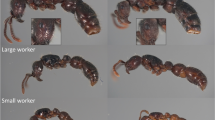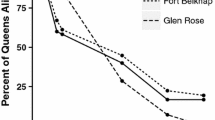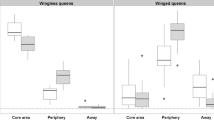Summary
Female and worker survivorship records are presented for several species of the archaic ant genusMyrmecia and are compared with some unpublished data of the authors for three genera of Ponerines and with values in the literature for certain higher ants. The evidence seems good that, even at the primitive grade of social development ofMyrmecia, survivorship capacities of fertilized brood females are comparable with those of many higher ants.
The Ponerine, Formicine, and Myrmicine species with which comparisons are made are all, with the exceptions ofMonomorium pharaonis andMyrmica sabuleti, primarily monogynous and with possible minor exceptions found their colonies haplometrically. This is also true of the species ofMyrmecia considered, but colony-founding females ofMyrmecia and of the Ponerine species addressed typically establish their colonies partially rather than entirely claustrally.
These survivorship patterns are in strong contrast to those recorded in the literature for both queens and workers of the highly opportunistic advanced Myrmicine speciesMonomorium pharaonis. The very short life-spans for queens and workers of this species, apparently adaptive to its peculiar and highly evolved life style, indicated, interestingly, a queen/worker survivorship ratio generally similar to that ofMyrmecia. Evidently the relatively long survivorship ofMyrmecia is consonant with that in many more advanced ants, but contrasts sharply with the very limited life-length characteristic ofMonomorium females and workers. It would be interesting to investigate this situation in other ants of life-style generally similar to that ofM. pharaonis.
Resume
Les statistiques de survie des femelles et des ouvrières sont présentées pour plusieurs espèces de fourmis archaïques du genreMyrmecia et sont comparées avec des données non publiées concernant trois espèces de Ponerines et avec des valeurs publiées dans des écrits sur certaines fourmis supérieures. Il semble évident que, même au niveau primitif de développement social desMyrmecia, les facultés de survie des femelles fertiles sont comparables à celles de beaucoup de fourmis supérieures.
Les espèces de Ponerines, Formicines et Myrmecines avec lesquelles les comparaisons ont été faites sont toutes essentiellement monogynes, à l'exception deMonomorium pharaonis et deMyrmica sabuleti, et, avec peut-être quelques exceptions, fondent leurs colonies de façon haplométrique. Ceci s'applique aussi aux espèces deMyrmecia étudiées.
Ces modèles de survie présentent un contraste important avec ceux qui figurent dans les écrits d'autres auteurs, à la fois pour les reines et pour les ouvrières deMonorium pharaonis. La longévité extrêment réduite des reines et des ouvrières de cette espèce, apparemment adaptée à son mode de vie particulier et hautement évolué, s'accompagne d'un rapport de survie entre reines et ouvrières relativement semblable à celui deMyrmecia. La survie relativement longue deMyrmecia concorde avec celle de beaucoup de fourmis plus évoluées, mais fait contraste avec la longévité très limitée des femelles et ouvrières deMonomorium. Il serait intéressant d'étudier cette situation parmi d'autres fourmis au mode de vie semblable à celui deM. Pharaonis.
Similar content being viewed by others
References
Brian-Michael V. 1972. — Population Turnover in Wild Colonies of the AntMyrmica.Ekologia Polska (Institute of Ecology, Polish Academy of Science).XX, 43–53.
Cited in Wilson,The Insect Societies, p. 429.Donisthorpe H. St. J.K., 1936. — The oldest insect on record.Entomologists' Record and J. Variation, 48, 1–2.
Gould W. (Rev.), 1747. —An Account of English Ants. London. Millar.
Gray B., 1974. — Nest Structure and Populations ofMyrmecia (Hymenoptera: Formicidæ) with Observations on the Capture of Prey.Insectes Sociaux. 21, 107–120.
Haskins C. P., Enzmann E. V. 1945. — On the Occurrence of Impaternate Females in the Formicidæ.Journal of the New York Entomological Society. Vol. LIII, 263–277.
Haskins, 1960. — Note on the Natural Longevity of Fertile Females ofAphœnogaster picea.Journal of the New York Entomological Society. Vol. LXVIII, 66–67.
Haskins C. P., Haskins E. F. 1950. — Notes on the biology and social behavior of the archaic ponerine ants of the generaMyrmecia andPromyrmecia.Annals of the Entomological Society of America 43, 461–491.
Hölldobler, Bert, Wilson E. O., 1977. — The number of queens: an important trait in ant evolution.Naturwissenschaften. 64, 8–15.
Cited in Wilson,The Insect Societies, p. 429.Janet C., 1904. — Observations sur les fourmis,Ducourtieux et Gout, Limoges, pp. 144.
Kutter H., 1974. — Reported inAnimal Architecture by Karl and Otto von Frisch.Harcourt Brace Jovanovich.London and N.Y., 104.
Lubbock, Sir John, 1882. —Ants, Bees and Wasps. International Scientific Series.D. Appleton & Co., N. Y., p. 41, and especially Preface p vi.
Cited in Wilson,The Insect Societies, p. 429.Peacock A. D., Baxter A. T., 1950. — Studies in Pharaoh's ant,Monomorium pharaonis (L.). 3. Life History.Entomologists' Monthly Magazine, 86, 171–178.
Petersen-Braun M., 1975. — Untersuchungen zur Sozialen Organization der PharaoameiseMonomorium pharaonis (L.) (Hymenoptera, Formicidæ). I. Der Brutzyklus und seine Steurung durch Populationseigene Faktoren.Insectes Sociaux. 22, 269–292.
Réaumur R. A. F., 1742. — Mémoires pour Servir à l'Histoire des Insectes, T. VI. Paris, Impr. Roy.
Wheeler W. M. 1928. — The Social Insects: International Library of Psychology, Philosophy and Scientific Method.Harcourt Brace and Company, N. Y. ..., 317.
Wilson E. O. 1971. —The Insect Societies. Belknap Press of the Harvard, University Press. Cambridge, ... 429.
Author information
Authors and Affiliations
Rights and permissions
About this article
Cite this article
Haskins, C.P., Haskins, E.F. Notes on female and worker survivorship in the archaic ant genus myrmecia. Ins. Soc 27, 345–350 (1980). https://doi.org/10.1007/BF02223727
Received:
Accepted:
Issue Date:
DOI: https://doi.org/10.1007/BF02223727




